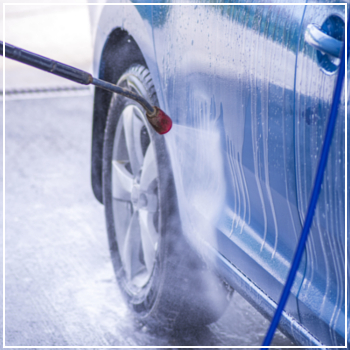Before diving into this DIY project, there are a few things you need to know to keep your car looking its best. While pressure washing may seem simple, it requires attention to detail to avoid costly mistakes. Contrary to common misconceptions, pressure washing isn't just about blasting your car with a high-pressure stream of water. The equipment itself is either electric or gas-powered, and the PSI (pounds per square inch) is adjustable. Using the wrong settings can lead to irreversible damage. Additionally, the nozzle angle can vary depending on the task, and many systems allow you to incorporate soap or cleaning agents for better results. To protect your car's finish, follow these guidelines: Once you're set up, make sure all doors, windows, and the trunk are closed before spraying down your car. Start by rinsing off loose dirt and debris from a distance of at least four to five feet. Afterward, apply detergent specifically designed for pressure washers and compatible with your vehicle's finish. Once the soap has had time to soak in, thoroughly rinse the car again. If you plan to use a brush with the pressure washer, ensure it’s clean and free of dirt. Otherwise, the combination of high pressure and trapped debris can scratch your car's surface. Wear sturdy, closed-toe shoes to protect your feet, as the force of the spray can be strong enough to cause injury. Despite its popularity, pressure washing your car is not without risks, as highlighted by publications like Consumer Reports. High PSI can easily strip paint or create micro-scratches that compromise the car's integrity, allowing rust to take hold. The high-pressure stream can also dislodge small stones or grit, which can act like sandpaper against the surface. Beyond the major risks, inexperienced users often encounter problems that can worsen over time: Instead of risking damage to your car, consider bringing it to DaSilva’s Auto Body for professional exterior detailing and rust removal services. Our team has the expertise to give your car a thorough cleaning without compromising its integrity. To schedule an appointment, contact our Naugatuck location today. Entry Level Cornet,Entry Level Professional Cornet,Plastic Cornet,Colorful Cornet ZhengOu Musical Instruments Co.,LTD , https://www.zomusical.com Many DIY car enthusiasts rave about pressure washing as a quick way to rid your car of grime and restore its showroom shine. It's seen as a more efficient alternative to hand-washing and waxing, saving time and effort. But with great power comes great responsibility—misusing a pressure washer can wreak havoc on your car, damaging the paint and exposing the metal beneath, potentially leading to rust.
Many DIY car enthusiasts rave about pressure washing as a quick way to rid your car of grime and restore its showroom shine. It's seen as a more efficient alternative to hand-washing and waxing, saving time and effort. But with great power comes great responsibility—misusing a pressure washer can wreak havoc on your car, damaging the paint and exposing the metal beneath, potentially leading to rust.How to Properly Pressure Wash Your Car
Potential Risks of Pressure Washing Your Car
How Pressure Washing Affects Your Car’s Paint Job